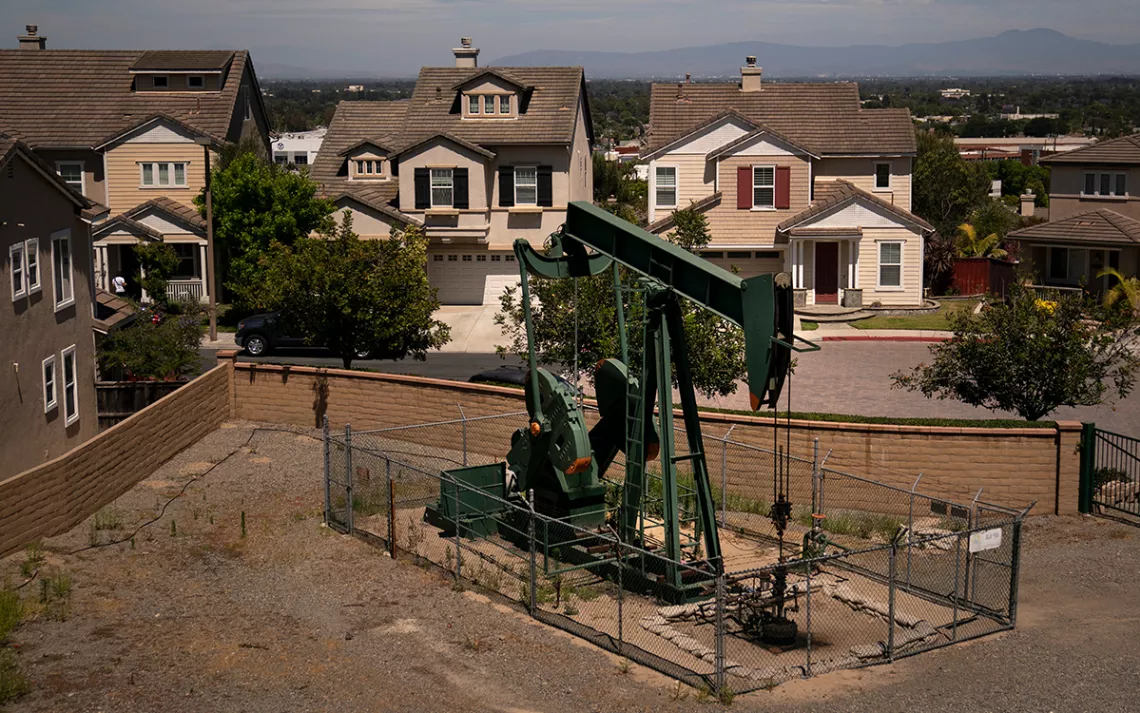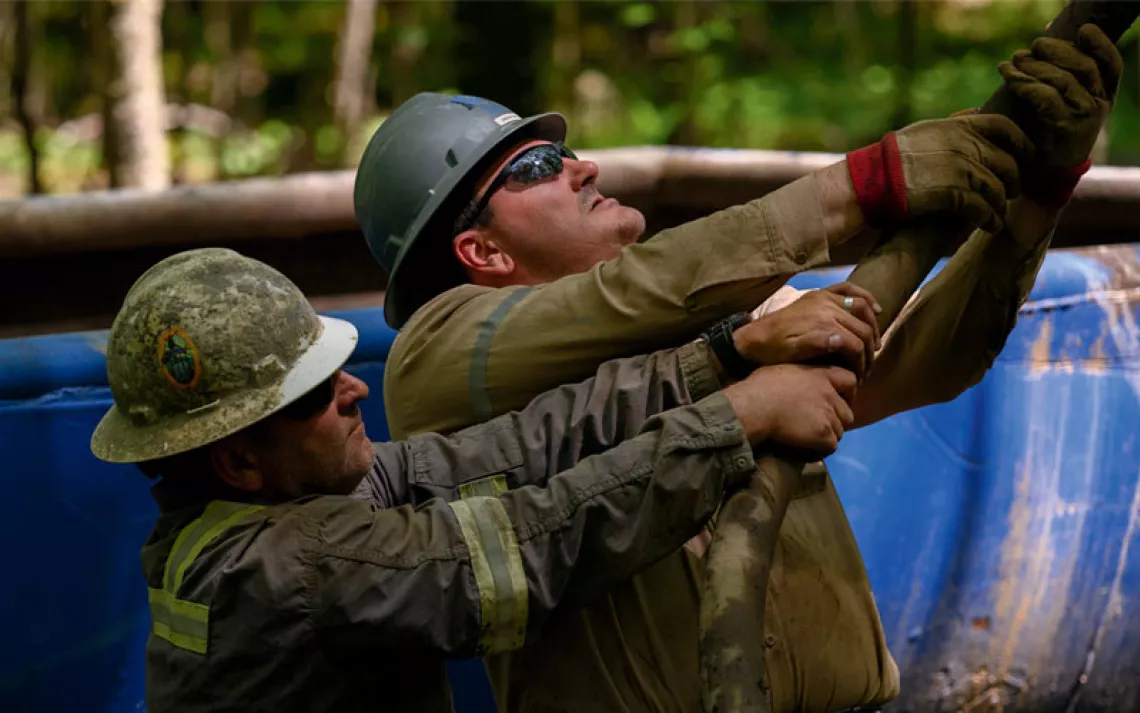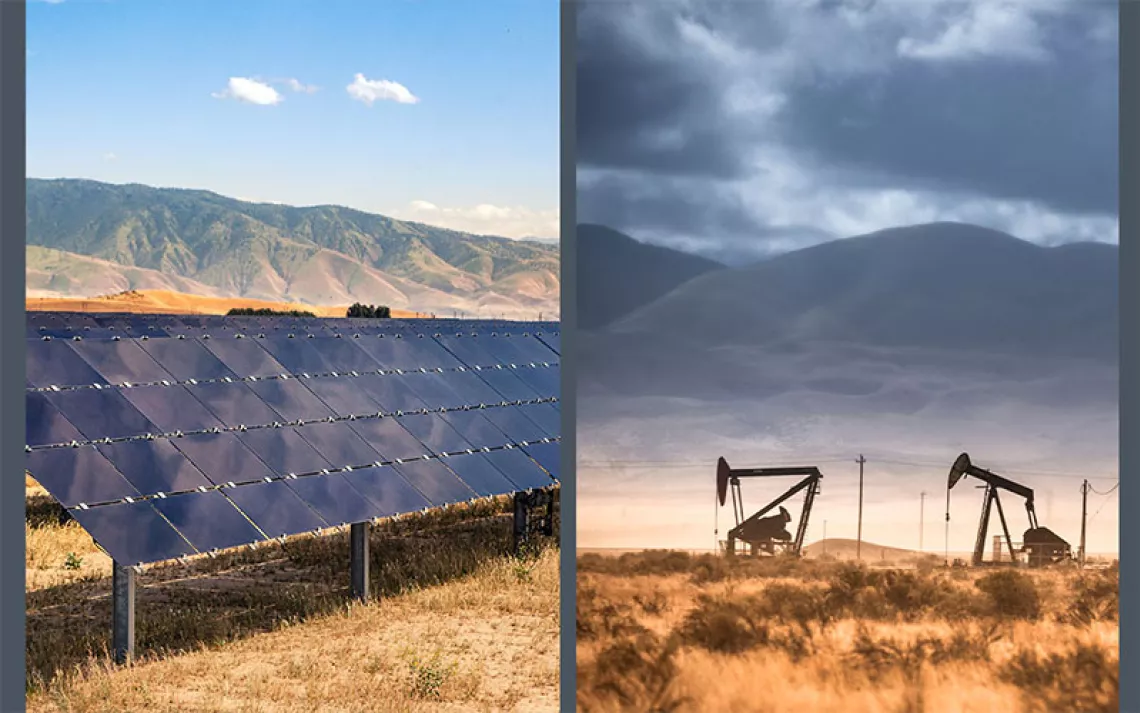Can Anything Stop the Backyard Drillers?
A California law banned them, but the oil industry won a do-over—and freedom to drill near homes, schools, and hospitals

A pump jack extracts oil at a drilling site next to homes in Signal Hill, California. | Photo by Jae C. Hong, AP File
California is the land of new beginnings. If you live there and the governor signs into law a bill you don’t like, you have 90 days to take a crack at stopping it. All you need to do is file a petition to repeal it with the secretary of state, get 623,212 people to sign that petition, and then persuade a majority of voters in the next election to do so. Even if you don’t win, you prevent the law from going into effect until Election Day at the earliest and forever if you win.
And during that time, you can do what the law would have prevented you from doing. Like, for instance, drilling an oil well a few hundred feet from your neighbor’s backyard.
That’s what the California Independent Petroleum Association and its allies did last winter: tried to overturn a new law that protected communities near oil and gas operations by exploiting California’s ballot referendum process. It’s called a “veto referendum” and California and 22 other states have one. CIPA’s “Referendum challenging 2022 law prohibiting new oil and gas wells near homes, schools, and hospitals,” means that enforcement of Senate Bill 1137, which required new oil and gas operations to maintain a safe distance from homes, schools, and hospitals, will be suspended until the next general election, on November 4, 2024.
In the meantime, oil and gas companies can drill away within what would have been buffer zones to protect the health and safety of adults and children living or working nearby. More than 7 million Californians live within a mile of an active well.
“It’s heartbreaking,” says Maricruz Ramirez, an organizer with the Center of Race, Poverty in the Environment (CRPE), based in oil-centric Bakersfield. “Two years is a long time for the people already suffering the harmful health impacts of living near oil and gas facilities. We’re talking about people who have higher rates of cancer and birth defects just because of where they live.”
For fossil fuel producers, two years is a good amount of time to drill new wells and rework old ones so drillers can stay in business until the wells run dry. “But for the people who live here,” Ramirez says, “it means two years of them continuing to suffer.”
The campaign to establish setbacks between oil and gas facilities and “sensitive areas” —homes, schools, hospitals, and the like—began more than a decade ago. It brought together environmental groups, social justice activists, researchers, and physicians. It involved more than a decade of demonstrations, lobbying elected officials, and a widespread public information campaign about oil-adjacent residents’ health problems, which included nosebleeds, headaches, and numbers of cancer deaths in excess of normal. Oil lobbyists went to great lengths to stop them, at one point bussing union members to the state’s capitol in Sacramento to testify against a more modest setbacks law, arguing that it would cut jobs. (“No one wants to come out against public health,” the Center for Biological Diversity’s Brian Nowicki told me at the time.)
Despite the petroleum industry’s efforts, however, the fight to establish a setbacks rule succeeded late last summer. Senate Bill 1137, to establish a buffer zone between those places people frequent and fossil fuel operations, passed the California legislature at the end of August. Governor Gavin Newsom signed it into law a few weeks later. The new law prohibited the drilling of new wells and the reworking of old ones within 3,200 feet of residential neighborhoods, schools, and hospitals. It also established new standards for existing wells to protect public health and safety. It was to go into effect on January 1, 2023.
Ramirez and her allies celebrated when SB 1137 passed, she says, “here in Bakersfield and with our friends in Arvin,” a literal fenceline city at the south end of the Central Valley’s sprawling oilfields, where a Chevron processing plant emits health-harming pollutants all night long. It wasn’t until an October staff meeting that a lawyer for CRPE told Ramirez and her colleagues that oil and gas producers were gearing up to overturn the law with a ballot referendum. “We had three weeks of happiness,” she says.
Planting fuzzily worded ballot measures on the California ballot has become a popular strategy among powerful industries that seek to free themselves from regulatory laws—or at least delay their implementation. Alongside CIPA’s referendum, the fast-food industry has a referendum on the ballot that would undo a state law raising the minimum wage and improving working conditions for workers. On the last general election ballot, “we had a referendum dealing with flavored tobacco,” Stern says. “People voted to uphold the law, but in the meantime the tobacco companies were able to sell it for another year and a half.”
It’s happening in other places too. In Eugene, Oregon, gas company NW Natural has put more than $1 million into a campaign to stop a new city law banning fossil fuel hookups in new low-rise residential construction. The group behind the referendum, Eugene Residents for Energy Choice, only needed 6,460 signatures to qualify for the ballot. On March 10, petitioners turned in nearly twice that amount to the Eugene City Recorder’s Office.
As a general rule in the referendum process, whoever spends the most money wins, says Bob Stern, cofounder of the Center for Governmental Studies, a California-based think tank. That’s in part because it’s easy to sow doubt and confusion when a law goes before voters. “When a referendum is on the ballot, a ‘yes’ vote means you support the bill,” Stern explains. A “no” vote means you support the referendum—in other words, you agree with overturning the bill. “And what we found with the initiative and referendum process is that if you have lots of money, it’s easy to get people to vote ‘no.’
“People get confused,” he says. “And if they’re confused, they vote ‘no.’”
The confusion often begins long before voting day: The petition process itself is often fraught with disinformation tactics. As Liza Gross reported in Inside Climate News last November, several people who had been confronted with the oil industry’s petition reported that signature gatherers were insisting that the ballot measure would ban oil drilling near homes and schools, not ban the banning. The Associated Press also reported that signature gatherers, some of whom made as much as $16 per signature, were telling people that “drilling near neighborhoods has no effect on human health” despite numerous studies to the contrary. CIPA itself billed its referendum as a call to “stop increased imports of oil from foreign countries.”
Ramirez says she and her partner were confronted outside a Bakersfield Target store by a signature gatherer with a petition to lower gas prices. She asked to take a look and saw that it was, in fact, a petition for the referendum to overturn SB 1137. “I turned to my partner and said, ‘This is the bill I’ve been talking about nonstop!’ It was just very shocking.” She had heard about the misleading pitches from signature gatherers, “but when it happens to you, you’re like ‘Whoa, you’re just lying to my face.’”
Signature gatherers might sometimes be ignorant of a petition's message, but in this case, the talking points likely came from CIPA. “Signature gatherers were given explicit talking points about how SB 1137 increases the state’s reliance on foreign oil, which is exempt from our strict environmental and labor laws,” CIPA’s CEO Rock Ziernan told AP in a statement. It’s not hard to understand the tactic: In a November poll by the Public Policy Institute of California, 74 percent of those surveyed said they support developing alternative energy sources over expanding oil, coal, and gas production. This is true even among respondents who say high gas prices have caused them economic hardship—evidence, perhaps, that voters aren’t buying the oil industry’s scare tactics warning that any state regulation will cost them at the pump.
For the next 18 months, however, public opinion counts for nothing. Even if voters figure out that they have to vote yes on the ballot referendum to uphold the law next year, drillers are free to get their backyard oil operations up and running before the state lowers the boom.
Which appears to have been the plan all along. As the setback restrictions loomed in the last few months of 2022, permits to drill new wells were up by 745 percent over the previous year. Nearly half of the permits were within 3,200-foot setback zones, according to the nonprofit groups Consumer Watchdog and FracTracker Alliance.
“The oil industry lied and cheated their way into getting this referendum on the ballot,” says Consumer Watchdog’s Liza Tucker. “They were prepared. They rallied the troops. For them, it’s all business as usual.”
 The Magazine of The Sierra Club
The Magazine of The Sierra Club



